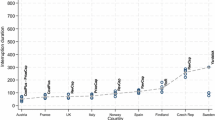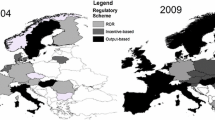Abstract
Following the reform of energy sectors, some countries have used engineering norm models in incentive regulation of network utilities. In 2003, Sweden adopted this approach to regulation of electricity distribution networks. This paper examines whether the norm models represent the real networks and create incentives for performance improvement. We analyse data from 138 network concession holders between 2000 and 2007. The results show that norm models are not adequate representations of real networks. Also, utilities that perform better than their norm models tend to behave opportunistically. Finally, we find that private utilities respond more strongly to incentives.
Similar content being viewed by others
References
Arellano M., Bond S. (1991) Some tests of specification for panel data: Monte Carlo evidence and an application to employment equations. Review of Economic Studies 58: 277–297
Armstrong, M. & Sappington, D. E. M. (2005). Recent developments in the theory of regulation. In M. Armstrong & R. Porter (Eds.), Handbook of industrial organization (Vol. III, pp. 1557–1687). New York: North-Holland.
Aubert C., Reynaud A. (2005) The impact of regulation on cost efficiency: An empirical analysis of Wisconsin Water Utilities. Journal of Productivity Analysis 23: 383–409
Berg S., Lin C., Tsaplin V. (2005) Regulation of state-owned and privatized utilities: Ukraine electricity distribution company performance. Journal of Regulatory Economics 28: 259–287
Burns P., Weyman-Jones T. (1996) Cost functions and cost efficiency in electricity distribution: A stochastic frontier approach. Bulletin of Economic Research 48: 41–64
Bustos, A. E. & Galetovic, A. (2004). Monopoly regulation, Chilean style: The efficient-firm standard in theory and practice. CEA Working Paper No. 180. Available at SSRN: http://ssrn.com/abstract=514243.
Coelli T., Rao D. S. P., Battese G. E. (2005) An introduction to efficiency and productivity analysis, 2nd edn. Springer, Berlin
Cowling K., Waterson M. (1976) Price-cost margins and market structure. Economica 43: 267–274
CPB. (2004). Better safe than sorry?—Reliability policy in network industries, Netherlands Bureau for Economic Policy Analysis, No. 73, December.
Cronin F. J., Motluk S. A. (2007) Flawed competition designing ‘markets’ with biased costs and efficiency benchmarks. Review of Industrial Organization 31: 43–67
Cropper M. L., Deck L. B., McConnell K. E. (1988) On the choice of functional form for hedonic price functions. Review of Economics and Statistics 70: 668–675
Domowitz I., Hubbard R. G., Petersen B. C. (1986) Business cycles and the relationship between concentration and price-cost margins. Rand Journal of Economics 17: 1–17
Estache, A., & Martimort, D. (1999). Politics, transaction costs, and the design of regulatory institutions. Policy Research Working Paper 2073. Washington DC: The World Bank.
Farsi M., Filippini M., Greene W. (2006) Application of panel data models in benchmarking analysis of the electricity distribution sector. Annals of Public and Cooperative Economics 77: 271–290
Färe, R., Martins-Filho, C., & Vardanyan, M. (2006). On functional form representation of multi-output production technologies. Mimeo, Department of Economics, Oregon State University.
Filippini M., Wild J. (2001) Regional differences in electricity distribution costs and their consequences for yardstick regulation of access prices. Energy Economics 23: 477–488
Goto M., Tsutsui M. (2008) Technical efficiency and impacts of deregulation: An analysis of three functions in U.S. electric power utilities during the period from 1992 through 2000. Energy Economics 30: 15–38
Grifell-Tatje’ E., Lovell C. A. K. (2003) The managers versus the consultants. Scandinavian Journal of Economics 105(1): 119–138
Hall, S., Walsh, M. & Yates, A. (1997). How do U.K. companies set prices? Bank of England Working Paper No. 67. doi:10.2139/ssrn.114948.
Hammond C. J., Jones G., Robinson T. (2002) Technical efficiency under alternative regulatory regimes: evidence from the inter-war British gas industry. Journal of Regulatory Economics 22: 251–270
Hirschhausen C., Cullmann A., Kappeler A. (2006) Efficiency analysis of German electricity distribution utilities—non-parametric and parametric tests. Applied Economics 38: 2553–2566
House of Commons: (1882) Bill to facilitate and regulate supply of electricity for lighting in Great Britain and Ireland: As amended by Select Committee, 1882 (200). House of Commons, London
Jamasb T., Pollitt M. G. (2001) Benchmarking and regulation: international electricity experience. Utilities Policy 9: 107–130
Jamasb T., Pollitt M. G. (2008) Reference models and incentive regulation of electricity distribution networks: An evaluation of Sweden’s network performance assessment model (NPAM). Energy Policy 36: 1788–1801
Joskow, P. (2007). Incentive regulation in theory and practice: Electric distribution and transmission networks. In N. Rose (Eds.), Economic Regulation and Its Reform: What Have We Learned? University of Chicago Press. http://www.nber.org/books_in_progress/econ-reg/joskow9-12-07.pdf.
Joskow P. J., Schmalensee R. (1986) Incentive regulation for electric utilities. Yale Journal of Regulation 4: 1–49
Kwoka J. E. (2005) Electric power distribution: economies of scale, mergers, and restructuring. Applied Economics 37: 2373–2386
Littlechild S. C. (1983) The regulation of British telecom’s profitability. HMSO, London
Martimort D. (1999) The life cycle of regulatory agencies: dynamic capture and transaction costs. Review of Economic Studies 66: 929–947
Nemoto J., Goto M. (2006) Measurement of technical and allocative efficiencies using a CES cost frontier: a benchmarking study of Japanese transmission-distribution electricity. Empirical Economics 31: 31–48
Pesaran, M. H. (2004). General diagnostic tests for cross section dependence in panels. University of Cambridge, Faculty of Economics, Cambridge Working Papers in Economics No. 0435.
Röller L.-H. (1990) Proper quadratic cost functions with an application to the Bell Systems. Review of Economics and Statistics 72: 202–210
Schaffer, M. E. (2007). xtivreg2: Stata module to perform extended IV/2SLS, GMM and AC/HAC, LIML and k-class regression for panel data models. http://ideas.repec.org/c/boc/bocode/s456501.html.
Schmidt M. R. (2000) Performance-based ratemaking: theory and practice. Public Utilities Reports, Inc, Vienna, VA
Shaffer S. (1998) Functional forms and declining average costs. Journal of Financial Services Research 14: 91–115
Shleifer A. (1985) A theory of yardstick competition. Rand Journal of Economics 16: 319–327
Short T. A., Mansoor A., Sunderman W., Sundaram A. (2003) Site variation and prediction of power quality. IEEE Transactions on Power Delivery 18: 1369–1375
SOU. (2007). Förhandsprövning av nättariffer m.m., delbetänkande av Energinätsutredningen, Statens Offentliga Utredningar 2007:99, Stockholm: Fritzes Förlag (in Swedish).
Söderberg, M. (2008). Four essays on efficiency in Swedish electricity distribution, Dissertation, Gothenburg University.
Söderberg, M. (2010). The role of model specification in finding the influence of ownership and regulatory regime on utility cost: the case of Swedish electricity distribution. Contemporary Economic Policy (in press).
Vogelsang I. (2002) Incentive regulation and competition in public utility markets: a 20-year perspective. Journal of Regulatory Economics 22: 5–27
Yu W., Jamasb T., Pollitt M. (2009) Does weather explain the cost and quality performance? An analysis of UK electricity distribution companies. Energy Policy 37: 4277–4388
Author information
Authors and Affiliations
Corresponding author
Rights and permissions
About this article
Cite this article
Jamasb, T., Söderberg, M. The Effects of Average Norm Model Regulation: The Case of Electricity Distribution in Sweden. Rev Ind Organ 36, 249–269 (2010). https://doi.org/10.1007/s11151-010-9246-8
Published:
Issue Date:
DOI: https://doi.org/10.1007/s11151-010-9246-8




